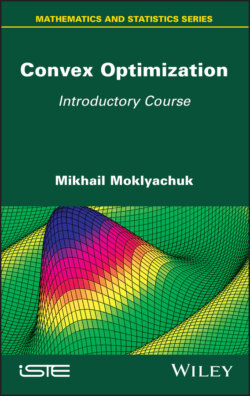Читать книгу Convex Optimization - Mikhail Moklyachuk - Страница 6
Оглавление
Introduction
Convex analysis and optimization have an increasing impact on many areas of mathematics and applications including control systems, estimation and signal processing, communications and networks, electronic circuit design, data analysis and modeling, statistics, and economics and finance. There are several fundamental books devoted to different aspects of convex analysis and optimization. Among them we can mention Optima and Equilibria: An Introduction to Nonlinear Analysis by Aubin (1998), Convex Analysis by Rockafellar (1970), Convex Analysis and Minimization Algorithms (in two volumes) by Hiriart-Urruty and Lemaréchal (1993) and its abridged version (2002), Convex Analysis and Nonlinear Optimization by Borwein and Lewis (2000), Convex Optimization by Boyd and Vandenberghe (2004), Convex Analysis and Optimization by Bertsekas et al. (2003), Convex Analysis and Extremal Problems by Pshenichnyj (1980), A Course in Optimization Methods by Sukharev et al. (2005), Convex Analysis: An Introductory Text by Van Tiel (1984), as well as other books listed in the bibliography (see Alekseev et al. (1984, 1987); Alekseev and Timokhov (1991); Clarke (1983); Hiriart-Urruty (1998); Ioffe and Tikhomirov (1979) and Nesterov (2004)).
This book provides easy access to the basic principles and methods for solving constrained and unconstrained convex optimization problems. Structurally, the book has been divided into the following parts: basic methods for solving constrained and unconstrained optimization problems with differentiable objective functions, convex sets and their properties, convex functions, their properties and generalizations, subgradients and subdifferentials, and basic principles and methods for solving constrained and unconstrained convex optimization problems. The first part of the book describes methods for finding the extremum of functions of one and many variables. Problems of constrained and unconstrained optimization (problems with restrictions of inequality and inequality types) are investigated. The necessary and sufficient conditions of the extremum, the Lagrange method, are described.
The second part is the most voluminous in terms of the amount of material presented. Properties of convex sets and convex functions directly related to extreme problems are described. The basic principles of subdifferential calculus are outlined. The third part is devoted to the problems of mathematical programming. The problem of convex programming is considered in detail. The Kuhn–Tucker theorem is proved and the economic interpretations of the Kuhn–Tucker vector are described.
We give detailed proofs for most of the results presented in the book and also include many figures and exercises for better understanding of the material. Finally, we present solutions and hints to selected exercises at the end of the book. Exercises are given at the end of each chapter while figures and examples are provided throughout the whole text. The list of references contains texts which are closely related to the topics considered in the book and may be helpful to the reader for advanced studies of convex analysis, its applications and further extensions. Since only elementary knowledge in linear algebra and basic calculus is required, this book can be used as a textbook for both undergraduate and graduate level courses in convex optimization and its applications. In fact, the author has used these lecture notes for teaching such classes at Kyiv National University. We hope that the book will make convex optimization methods more accessible to large groups of undergraduate and graduate students, researchers in different disciplines and practitioners. The idea was to prepare materials of lectures in accordance with the suggestion made by Einstein: “Everything should be made as simple as possible, but not simpler.”
